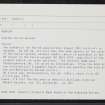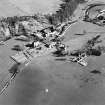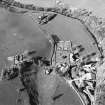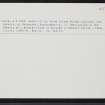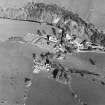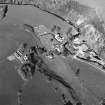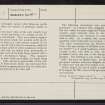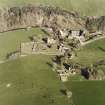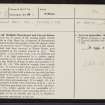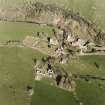Hobkirk
Architectural Fragment (Medieval), Burial Ground (Period Unassigned), Church (19th Century)
Site Name Hobkirk
Classification Architectural Fragment (Medieval), Burial Ground (Period Unassigned), Church (19th Century)
Canmore ID 55330
Site Number NT51SE 5
NGR NT 587 109
Datum OSGB36 - NGR
Permalink http://canmore.org.uk/site/55330
- Council Scottish Borders, The
- Parish Hobkirk
- Former Region Borders
- Former District Roxburgh
- Former County Roxburghshire
NT51SE 5 587 109.
Hobkirk Churchyard and Carved Stones. Beside the N porch of the existing parish church, built in 1869, there lies a fragment of Romanesque detail from the chancel arch of the old church, which is on record in 1220 (Register of Glasgow, i, 98). Further relics of this church, which had been removed to Weens House, were assembled in the modern church in 1937. They include:
(1) A circular shaft 12 in. in diameter and 1 ft. 2 in. high surmounted by a cushion capital measuring 7 1/2 in. from below its circular necking to the top, which is oblong on plan and measures 1 ft. 2 in. by 1 ft. The whole is wrought from a single stone. It seems to have been put to secondary use as a piscina, as a basin 8 in. in diameter by 3 in. deep and provided with a drain on the side has been formed in the upper surface.
(2) Two capitals of a double respond of an early type, each showing a spiral volute and measuring 1 ft. in height, 1 ft. 2 in. in greatest breadth with a thickness of 9 3.4 in.; one is carved from grey stone, the other one from red stone.
(3) Two ornate capitals for the nookshafts of a Romanesque doorway, each measuring about 1 ft. in height, 10 in. in breadth and 7 1/2 in. in thickness. They are intricately carved with foliaceous scrolls emerging from the mouths of grotesque masks on the angles.
In 1950 two more relics of the early church were recovered in the demolition of a cottage on the W side of the churchyard. They were placed, together with a third stone, beside the modern north porch. The first of these is a 12th-century voussoir of red sandstone carved with a chevron ornament, while the second is a large corbel of yellow sandstone carved on the outer side with an animal head, presumably an ox, the upper part of the head being covered with a drapery or conventional foliage. This measures 1 ft. 4 in. in both width and height, the depth being 2 ft. 2 in. This carving is presumably of the 12th century. A third stone, which was recovered from the churchyard, is apparently the foot of a coffin slab, rounded and pierced at is wider end.
The following monuments were noted in the graveyard:
(1) a massive slab, originally recumbent but now raised on stone supports (G Tancred 1907), commemorating MAISTER IAMES DOWGLAS SONE TO THE LAIRD OF BOONIEDB(VR)GH LATE MINISTER OF HOBKIRK, who died in 1665. (2) A similar slab, recumbent, and inscribed I HAVE FIN(ISH)/ED MY COVR(SE)/MWM 1651. This stone commemorated the Reverend William Weir, who was minister of Hobkirk from 1626 until his death (G Tancred 1907) (3) A small headstone commemorating GILBERT ALMOS, who died in 1670, and his wife ELIZABETH SCOTT, the rest of the inscription being illegible. The lettering is very crude, and the W of "wife" has been cut upside down. In addition, the graveyard contains numerous illegible stones, some of which may well date from before 1707.
Of the chapel, the site of which is marked on the OS map at the NE corner of the graveyard, nothing now survives.
RCAHMS 1956, visited 1931, 1933, 1945, 1950.
The authority for the OS publication: Chapel (NR) (site of) is unknown. On 1st ed. 6" map (1863), the name appears in the centre of the burial-ground, without symbol, which is published in the NE corner of the burial-ground (NT 5871 1093) some 20m N of the present church, on later editions. The relevant Name Book gives no information. (From the date of the architectural fragments found, this was possibly the site of the pre-Reformation parish church.)
Name Book 1858; J Curle 1904; I B Cowan 1967























